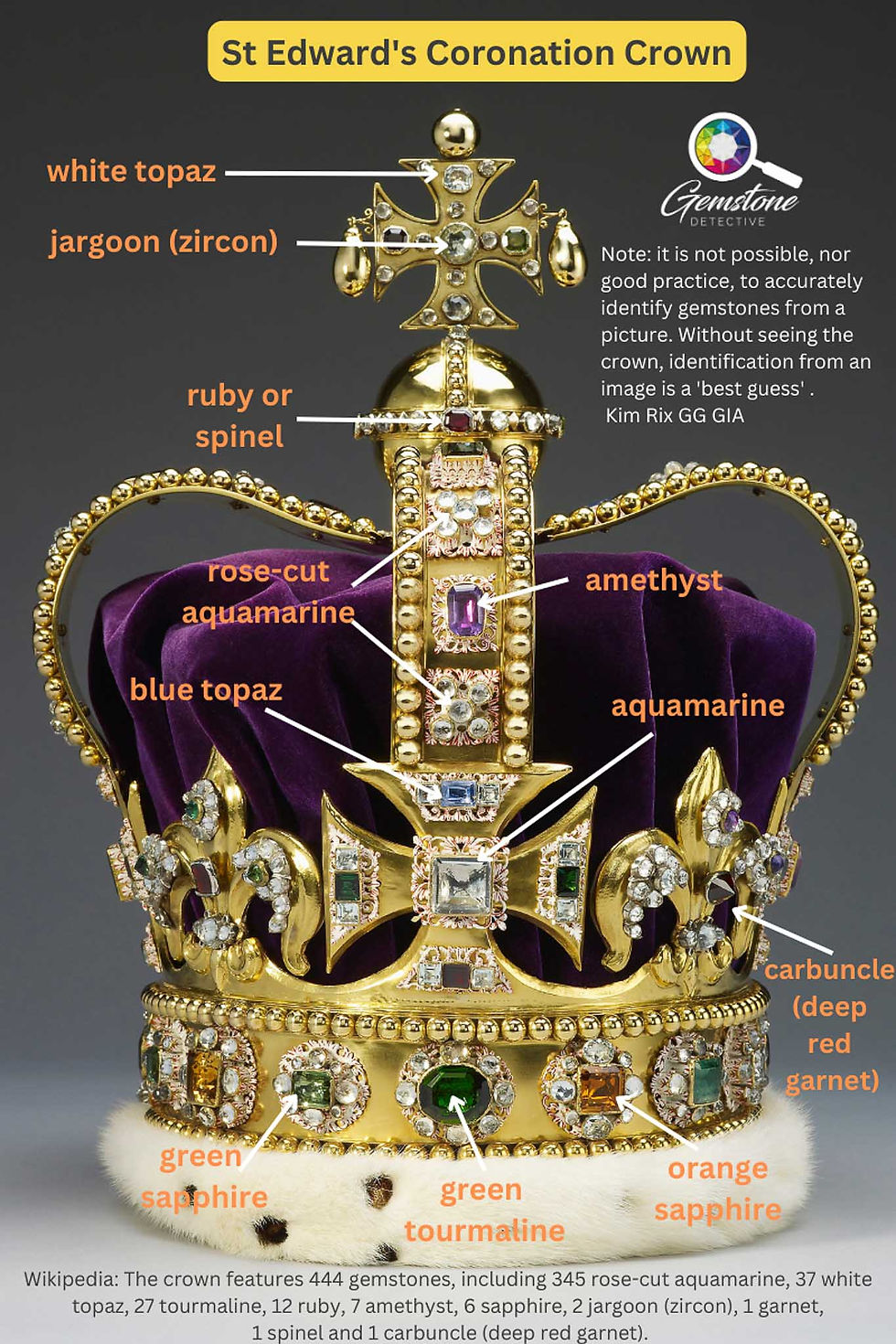Identifying gemstones in The St Edward's Crown - an experts point of view
- Kim Rix

- May 3, 2023
- 3 min read
The term “rare” is often related to the notion of gemstones. When people try to determine the value of precious stones, they ask about their rarity. The truth is many gems are quite common, but certain types cannot be found that easily. It takes an expert eye to establish whether a specific stone is considered rare or valuable.
The St Edward's Crown is made with the finest attention to detail, and each gem included is carefully eyed and selected. Even though historically it has undergone many changes for each royal coronation, there was a unique choice of stones each time. However, not many people know whether the gems, whatever their type, are rare or not.
I have been asked whether it is easy to recognise the stones used in the royal crown. Moreover, many have been puzzled by the importance of the gem’s size. To find out the answer to these questions, one must have an impeccable knowledge of gemstones, and size is not the only factor.

According to Wikipedia, the current diadem is adorned with a total of 440 gemstones. This includes 12 rubies and 6 sapphires which are regarded as two of the four most valuable gems, alongside diamonds and emeralds. When people think of sapphire, they usually picture a rich blue stone, which is indeed the most treasured variety. However, sapphires come in other colours as well, such as grey, black, purple, green, pink, colourless, and even pinkish-orange, known as padparadscha.
Ruby just like sapphire is another stone that belongs to the corundum family. The simple distinction between the two is that if a corundum is red in colour, it is called a ruby. Otherwise, it is classified as a sapphire.
However, ruby and sapphire are no longer considered the most valuable or expensive gems in the world today. This is partly because other gemstones are much rarer, hence more highly prized. For instance, Jadeite jade is widely known as the most costly stone ever discovered.
On the other hand, rare stones like alexandrite, taaffeite, musgravite, painite, and red beryl are extremely scarce, making it difficult even to determine their true value. These gemstones' rarity adds to their value and makes them highly coveted by collectors and enthusiasts.
The Gemological Institute of America (GIA) established the diamond grading system in 1953. Gemmologists typically refer to the "Four C's" - Cut, Clarity, Carat (weight), and Colour - when assessing the value of a diamond. Interestingly, these same attributes can also be used to evaluate other coloured gemstones.
When assessing a gemstone, it is important to consider all four of these characteristics. Carats, for example, refer to the weight of a stone. So, heavier stones are generally more valuable due to their rarity, especially when they weigh over 5 carats. In other words, when all other factors are equal, a gemstone with a higher carat weight is likely to be more expensive than one with a lower weight.
In conclusion, the rarity of gemstones is a significant factor contributing to their value and desirability. While sapphires and rubies were once considered the most valuable gems, discovering other rarer stones has shifted the industry's landscape. Jadeite jade, alexandrite, painite, and red beryl are just a few examples of highly sought-after and expensive precious jewels due to their uncommonness.
Ultimately, the rarity of gemstones adds to their mystique and allure, making them prized possessions for collectors and enthusiasts worldwide. Regarding the Royal Crown, it goes without saying that each stone has been selected with the utmost precision. Since it is a magnificent intricacy admired worldwide, the requirement of rare stones is a must.
Stay tuned for the 4th and final blog post in this Coronation Crown series. We will take a closer look at three gemstones used in the original crown that are said to have mystical powers!
Further reading: 3-d video look at the Coronation Crown, article published by the BBC.
Gemstone Detective
Kim Rix GG GIA
Be sure. Be smart. Buy with confidence





Comments